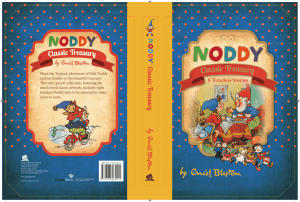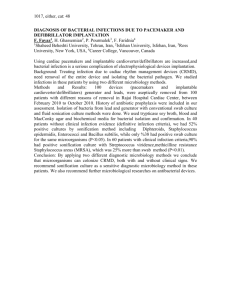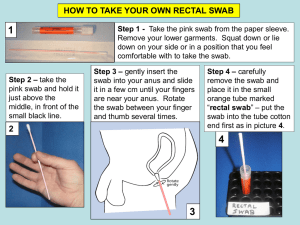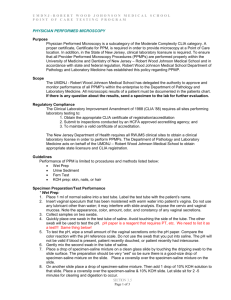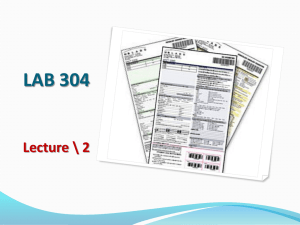Word - 1880KB - Department of the Environment
advertisement
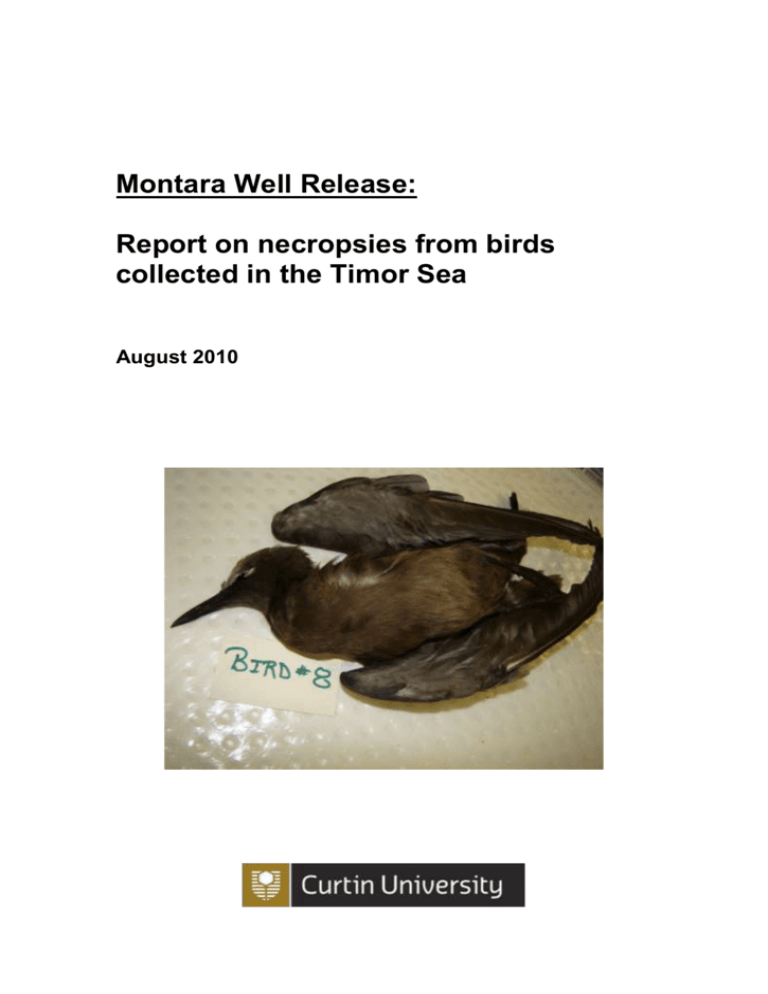
Montara Well Release: Report on necropsies from birds collected in the Timor Sea August 2010 NECROPSIES ON TIMOR SEA BIRDS Preface This report was prepared by Associate Professor Marthe Monique Gagnon and Dr Christopher Rawson from the Department of Environment and Agriculture, Curtin University. Bird specimens collected from various sites during and after the Montara well release were shipped to Curtin University where they were dissected and necropsies collected in the Ecotoxicology laboratories, Curtin University. Acknowledgements Special thanks to Dr Stephen Davies and Dr Christine Cooper expert advice and assistance with dissection. For further information contact Associate Professor Marthe Monique Gagnon Department of Environment and Agriculture Curtin University, GPO Box U1987 Perth, Western Australia, 6845 Tel: (08) 9266 3723 Email: m.gagnon@curtin.edu.au Recommended Citation Gagnon, M.M., Rawson, C. A., 2010. Montara Well Release: Report on necropsies from birds collected in the Timor Sea. Curtin University, Perth, Western Australia. 20 pages. 2 NECROPSIES ON TIMOR SEA BIRDS Summary of Results Necropsies were collected from 16 birds (13 common noddy, 1 lesser frigatebird, 1 wedge-tailed shearwater, 1 brown booby) collected in the Timor Sea during and following the Montara well release. A total of 72 samples (38 samples of lungs, breast tissue or gizzard contents, 32 swab samples from feathers and trachea, 2 bile samples) were analysed for the presence of total petroleum hydrocarbons (TPH - gas chromatography with flame ionisation detection) and polycyclic aromatic hydrocarbons (PAH – gas chromatography-mass spectrometry). Expert examination of the chromatographic pattern produced in the TPH analysis allowed the qualitative assessment of whether the source of the compounds was petroleum hydrocarbons and/ or biological co-extractives (e.g., fatty acids, cholesterol). One common noddy (collected deceased) from the vicinity of the Montara incident had crude oil on its feathers, in its gizzard contents, in its lungs and in its breast tissue indicating significant exposure to crude oil. Since this bird was very decomposed upon receipt (thoracic cavity open and intestine missing) such exposure could have been pre- and/ or post-mortem. One common noddy collected at Ashmore Reef had crude oil in its lungs but in no other samples (feather swab, trachea swab, breast tissue, gizzard). The fact that external swabs and intestinal tract samples were negative for the presence of crude oil suggests non-recent exposure. The remaining 14 birds submitted for analysis had no signs of crude oil in the feathers, in the gizzard contents, in the lungs or in the breast tissues. The majority of birds submitted for analysis appeared in poor physical condition and are likely to have died of natural causes. 3 NECROPSIES ON TIMOR SEA BIRDS Table of Contents Background .................................................................................................................... 5 Collection Locations ................................................................................................... 5 Samples received ....................................................................................................... 5 Necropsies Collected.................................................................................................. 9 Chemical Analysis ........................................................................................................... 9 Results and Interpretation ........................................................................................... 12 References ................................................................................................................... 19 4 NECROPSIES ON TIMOR SEA BIRDS Background In August 2009 the Montara well in the Timor Sea released crude oil and gas condensate to the surrounding environment causing concern over the impacts of exposure to petroleum compounds on wildlife. In the following months a number of deceased birds suspected of being impacted by the release were collected from the region. A small number of live birds which later died in captivity were also collected. Associate Professor Marthe Monique Gagnon from Curtin University was contracted by the Australian Government Department of Environment, Heritage, Water and the Arts (DEWHA) to receive deceased birds suspected of exposure to the products of the well release and collect appropriate necropsies for chemical analysis to confirm if exposure to petroleum compounds had occurred. Collection Locations Specimens were received with varying degrees of information regarding sampling location, date of collection and the identity of the collector. Most of the specimens received at Curtin University were accompanied by GPS coordinates. Other specimens were accompanied by named locations of collection allowing the GPS coordinates to be gathered from online geographic databases. A small number of specimens were received with no information on the location of collection. Figure 1 shows the known locations of collection of the specimens received for necropsy. Samples received Bird specimens were received at Curtin University between November 2009 and March 2010. All samples were received frozen. This information is summarised in Tables 1. Briefly the specimens received were 13 common noddy (Anous stolidus), one wedge-tailed shearwater (Puffinus pacificus), one lesser frigatebird (Fregata ariel) and one brown booby (Sula leucogaster). 5 -10° -10° Bird Collection Sites Joint Petroleum Development Area Timor Sea Ashmore Reef Bird Collection Site ^ Av14 West Atlas Av11 Av12 Av16 Av13 Av15 Av7 Aust. EEZ ^ Av8 Av5 Av4 Av1 Av2 Av10 : 0 Robinson Projection 37.5 75 150 Nautical Miles Central Meridian: 140.00 Figure 1. Location of the West Atlas drilling platform and the locations where the samples necropsied were collected. Samples Av3, Av6 and Av9 were received with no collection location information. Table 1. Information on bird specimens received at Curtin University. Specimens are presented according to the collection date. U = Unknown (information not received with specimen). Common Name ID Date Collected Collected by Common noddy Av1 30/09/2009 James Watson Common noddy Av2 1/10/2009 Damian Tedon Common noddy Av11 13/10/2009 Phillipa Wilson Common noddy Av12 14/10/2009 Phillipa Wilson Common noddy Av16 14/10/2009 Phillipa Wilson Common noddy Av14 23/10/2009 A. Williams Wedge-tailed shearwater Av4 23/10/2009 T. Budd Common noddy Av13 27/10/2009 David Bond-Smith Common noddy Av15 27/10/2009 Common noddy Av8 Lesser frigatebird Location GPS 12.62757 S 124.62811 E 12.75650 S 124.56000 E Middle Island 12.27158 S 123.04118 E Middle Island Middle Island West Island Middle Island 12.27158 S 123.04118 E 12.27158 S 123.04118 E 12.24324 S 122.97030 E 12.78317 S 124.50683 S 12.27158 S 123.04118 E David Bond-Smith Middle Island 12.27158 S 123.04118 E 31/10/2009 Suzy Roworth East Island 12.26583 S 123.10865 E Av7 10/11/2009 Marissa Spiers Middle Island 12.27158 S 123.04118 E Common noddy Av10 14/11/2009 Marissa Spiers Common noddy Av3 U Browse Island U 14.11068 S 124.54848 S U U Comments (with specimen) Collected at sea alive floating in an oil slick. Died 10 hours post collection. Nil Label: Common noddy #16. Middle Is. 13/10/09 1700hrs. With possible oil contamination (dorsal surface). Weight = 100g. Fed but not washed. Dead 14/10/09 0700hrs. Found dead on Middle Is. 14/10/09 0830hrs. Montara oil spill. Possible oil contamination. Common noddy. Found dead on Middle Is. 0830 14/10/09. Label: AW 23-10-01. Found deceased near West Is. Ashmore Reef 23/10/09 Bird recovered near surface oil. Transferred from First Class to Sea Spirit (25/10/09). Received from Sea Spirit 25/10/09 Barbara Ross Found 27/10/09 Middle I. North side. GPS co-ords unknown. Found on high tide mark. Oil suspected. Found dead. Label: DBS-01. Common noddy. Found 27/10/09. Middle Is. East side. Not able to give GPS. Found dead on water line. Oil suspect on head and breast. Label: Common noddy 17. East Island. Hydrated and washed. Found dead 01/11/09 in bird cage. Label: MS-01. Collected eastern side of Middle Is. Found washed up. Very freshly dead. Highly doubt it is oiled but collected as precaution. Label: MS-04. Found half-way up beach slope ion southern side of Browse Island. Nil Table 2. (cont.) Date Collected Common Name ID Collected by Location GPS Common noddy Av5 U U U East Island U 12.26583 S 123.10865 E U Common noddy Av6 U Brown booby Av9 U U U U Comments (with specimen) Nil Nil Nil NECROPSIES ON TIMOR SEA BIRDS Necropsies Collected All specimens were dissected on clean dissection mats using rinsed (HPLC-grade hexane) dissection tools. Swabs were taken using sterile cotton Livingstone swabs. All tissue samples and swabs were wrapped in hexane rinsed aluminium foil and stored at -20oC. External swabs of feathers were taken initially. Primary incisions down the ventral midline allowed access for the remainder of the necropsies. Some specimens were clearly collected some time post mortem as evidenced by desiccation, the presence of maggots and by body damage caused by scavengers. In some instances it was not possible to collect all necropsies as some organs had been consumed by predators, scavengers or decomposers. Where possible; Swabs were taken in the trachea (close to the lung), Bile was collected Lung tissue was excised, Breast muscle was excised, The contents of the gizzard were collected were possible. Chemical Analysis A total of 72 samples (38 samples, 32 swab samples, 2 bile samples) were transported to Advanced Analytical Ltd. for the quantification of total petroleum hydrocarbons (TPHs - C10-14, C15-28, C29-36) and 19 individual polycyclic aromatic hydrocarbons (PAHs). The methods used for TPH and PAH quantifications were Advanced Analytical methods 04-020 and 04-077, respectively. The samples were extracted (acetone: hexane) and analysed using gas chromatography with flame ionization detection (GC-FID) for the presence of total petroleum hydrocarbons. The extraction of petroleum hydrocarbons from biological samples results in the coextraction of biological compounds (e.g., fatty acids, cholesterol) and the presence of these can bias the results. These biological extractives have characteristic 9 NECROPSIES ON TIMOR SEA BIRDS chromatographic patterns and examination of individual chromatographic patterns of each extract in which hydrocarbons are detected allows the identification of the presence of either petroleum hydrocarbons, biological extractives or both. The TPH concentrations reported are the sum of the petroleum hydrocarbons and the biological extractives since their co-extraction renders their separate quantification not possible. Individual PAHs were quantified using GC-MS. Limits of reporting are shown in Table 2. Table 2. Limits of reporting for chemical analytes. The limits of reporting vary according to the amount sample provided and the level of matrix interference. TPH (mg/ kg) PAH (µg / kg) TPH C 10 – 14 TPH C 15 – 28 TPH C 29 - 36 Naphthalene 1-Methylnaphthalene 2- Methylnaphthalene Acenaphthalene Acenaphthene Fluorene Phenanthrene Anthracene Fluoranthene Benz(a)anthracene Chrysene Benzo(b)&(k)fluoranthene Benzo(a)pyrene Indeno(1,2,3-c,d)pyrene Dibenz(a,h)anthracene Benzo(g,h,i)perylene Coronene Benzo(e)pyrene TOTAL PAH Tissue / Gizzard contents 200 - 2500 400 - 5000 400 - 5000 50 - 500 50 - 500 50 - 500 50 - 500 50 - 500 250 - 2500 50 - 500 50 - 500 50 - 500 50 - 500 50 - 500 100 - 1000 50 - 500 250 - 2500 250 - 2500 250 - 2500 50 - 500 50 - 500 1000 - 10000 10 Bile 2500 -12500 5000 - 25000 5000 - 25000 500 - 2500 500 - 2500 500 - 2500 500 - 2500 500 - 2500 2500 -12500 500 - 2500 500 - 2500 500 - 2500 500 - 2500 500 - 2500 1000 - 5000 500 - 2500 2500 - 12500 2500 - 12500 2500 - 12500 500 - 2500 500 - 2500 10000 - 50000 Swab (µg/swab) 125 250 250 10 10 10 10 10 10 10 10 10 10 10 10 10 10 10 10 10 10 10 Table 3. Observations made on bird carcasses during dissection. Total Wt (g) Head to Bill (mm) Wing L (mm) Av1 123.51 74.52 262 Common noddy Av2 150.88 75.24 269 Common noddy Av11 76.21 72.72 255 Common noddy Av12 83.55 75.44 258 Common noddy Av16 51.88 76.18 267 Common noddy Wedge-tailed shearwater Av14 81.40 75.51 253 Feathers look disrupted, barbules not interlocked (probably due to washing while alive). Many parasitic worms in proventriculus. Stomach empty. Very digested contents of intestine. Very decomposed. Thoracic cavity open at bottom. Intestine missing. Stomach empty. Feathers very oily. Bird appears to have been starved (green and white cloaca, breast bone very exposed). Tissues fresh and not desiccated. No sign of oil. Slightly decomposed. Bird has been dead for a long time. Maggots have consumed the lungs. Abdominal cavity is empty and desiccated. Desiccated breast tissue collected. No visible oil on/in this bird. Animal probably dead for several days (lungs brownish). Av4 228.62 94.84 292 No visible oil. Common noddy Av13 94.18 76.30 257 Common noddy Av15 78.90 78.90 272 Common noddy Av8 57.77 71.93 260 Lesser frigatebird Av7 890.00 164.09 570 Common noddy Av10 56.53 79.25 269 Common noddy Av3 80.97 72.87 246 Common noddy Av5 88.60 76.85 265 Common noddy Av6 136.52 83.93 282 Brown booby Av9 258.85 156.69 370 Common Name ID Common noddy Observations during dissection No visible oil but bird has wet feathers. Acceptable to poor body condition. Slightly skinny. Looks freshly dead. No visible oil. One lung damaged but cause of decomposition unknown. Bird is very skinny (looks starved). Almost no breast tissue. No stomach contents. No intestinal contents. No sign of oil on feathers. No sign of oil. Coarse white sand in wings. No sign of oil on feathers. Maggots present. Desiccated. Feathers dry. No visible oil. Shell grit covering body. Half decomposed. Very smelly. Abdominal cavity open. Lungs very decomposed - no biopsy of gizzard contents, breast or lungs. Feathers clean and fluffy. Parasites (white, 15mm long, stiff) in the proventriculus Feathers dirty with excrement. Otherwise clean Likely juvenile (bluish green feet). Very decomposed. Thoracic cage rotten and open. Maggots present. Desiccated. Very sandy (fine and coarse sand). Bird has been dead for several weeks. No muscle tissues or internal tissues left. Only bones and feathers. NECROPSIES ON TIMOR SEA BIRDS Results and Interpretation Tissues samples from all birds sampled had reportable concentrations of total hydrocarbons. However, expert examination of the chromatographs revealed that most of the birds had chromatographic patterns indicating the presence of biological extractives (fatty acids and cholesterol) with no evidence of petroleum hydrocarbons. Tissue (breast, lung) samples and gizzard contents from one common noddy (Av2) had chromatographic patterns suggesting the presence of crude oil. The gizzard contents and the breast tissue collected on this bird also contained measurable concentrations of PAHs. The swab of the feathers of this bird similarly suggested the presence of crude oil. When this bird was examined the presence of large amounts of an oily substance was noted on all surfaces and, based on the degree of decomposition this bird had been dead for some time prior to collection. The fact that crude oil was found in the gizzard indicates that the bird had ingested the oil or that the oil had found its way inside the body post mortem. With the degree of decomposition noted it is not possible to suggest which of these scenario is the most likely to have occurred. The analysis of lung tissue from an additional common noddy specimen (Av13) collected at Ashmore Reef resulted in chromatographic patterns indicating the presence of crude oil. This specimen showed no evidence of crude oil on the feathers suggesting no (or very little) external exposure. Further, no crude oil was picked up in the swab of the trachea indicating that the crude oil in the lung tissue is unlikely due to recent exposure. It is likely that this bird had inhaled floating crude oil while foraging in the weeks preceding its death however, it is not possible to ascertain if exposure to crude oil is the cause of death. 12 NECROPSIES ON TIMOR SEA BIRDS According to information supplied with the specimen, Av1 was collected while alive and floating in an oil slick. It is not clear from the information supplied whether this bird was later washed prior to death. Since analysis of the feather swabs taken from Av1 indicated no presence of petroleum hydrocarbons, this is likely the case. Gizzard content and lung necropsies taken from Av1 detected no evidence of exposure to petroleum hydrocarbons indicating that the bird had not ingested or inhaled petroleum hydrocarbons. It was not clear from the information provided whether Av4 was collected alive or dead. It was stated that the bird was recovered “near surface oil”. None of the necropsies collected on Av4 were positive for petroleum hydrocarbons. As the external swabs did not show evidence of petroleum hydrocarbons either the bird was collected alive and washed prior to death or had not been exposed to the surface oil near which it was collected. PAHs are readily accumulated in aquatic filtering organisms such as mussels, but not in fish, birds and mammals because vertebrate species are capable of metabolising PAHs at rates that prevent significant bioaccumulation (Hartung 1995). However, illeffects associated to chronic (long-term) exposure to crude oil have been commonly observed in wildlife (Budzinski et al. 2004; Marty et al 2003; Barsiene et al 2006). In seabirds, chronic effects such as increased DNA damage (Laffon et al., 2006) and altered metabolism (Oropesa et al. 2007) were observed following the Prestige oil spill in 2002. In the year following the Prestige spill, monitoring of the reproductive activities of adults birds showed that effects observed in exposed adults were much reduced in the next generation of chicks (Alonso-Alvarez et al. 2007). Petroleum body burden in wildlife is expected to reduce rapidly following the cessation of exposure. For example, blood concentrations of PAHs in seabirds oiled by the Prestige incident have reduced 3-fold in just one year, down to background levels observed in reference bird populations (Perez et al, 2008). 13 NECROPSIES ON TIMOR SEA BIRDS The prestige oil spill involved a heavy fuel-oil which generally causes more intense and profound effects on wildlife than lighter crude oils would. The Montara well release involved light crude oil and condensate which are very volatile and thus, would have dispersed rapidly in the environment. In summary, chemical analysis of the 16 specimens suspected of being exposed to crude oil from the Montara well release revealed that only two individuals had detectable levels of petrogenic hydrocarbons in or on their body. The majority of birds submitted for analysis appeared in poor physical condition and are likely to have died of natural causes. 14 Table 4. Total hydrocarbons in bird samples. Bile samples are excluded as all were below the detection limits. Samples in bold are measured as above the detection limit. Highlighted samples denote those where chromatographic patterns indicated the presence of petroleum hydrocarbons. Tissue samples are expressed in mg/ kg for TPH and swabs are expressed in µg/swab. Gizzard Common Name ID Common noddy Breast Lung Feather Swab Trachea Swab C10-14 C15-28 C29-36 C10-14 C15-28 C29-36 C10-14 C15-28 C29-36 C10-14 C15-28 C29-36 C10-14 C15-28 C29-36 Av1 <500 5600 2900 <500 11000 1400 <2500 6600 10000 <125 <250 <250 <125 <250 <250 Common noddy Av2 <1000 7200 4700 <1000 6200 2500 <2500 <5000 <5000 890 50000 6500 <125 <250 <250 Common noddy Av11 <5000 2700 3000 <200 2700 1300 <1000 2300 7600 <125 <250 <250 <125 <250 <250 Common noddy Av12 <500 3800 3000 <200 2300 1200 <500 3600 6200 <125 <250 <250 <125 <250 <250 Common noddy Av16 <200 2400 1500 <125 <250 <250 <125 <250 <250 Common noddy Av14 Wedge-tailed <500 2300 2900 <200 3300 1700 <1000 <2000 7000 <125 <250 <250 <125 <250 <250 <500 2500 3300 <200 3000 2300 <1000 2700 8800 <125 <250 <250 <125 <250 <250 shearwater Av4 Common noddy Av13 <500 2500 2700 <200 4800 1700 <1000 2600 6900 <125 <250 <250 <125 <250 <250 Common noddy Av15 <200 870 1300 <200 5200 1500 <1000 <2000 6500 <125 <250 <250 <125 <250 <250 Common noddy Av8 <200 2200 3600 <500 2600 2000 <1000 2400 7500 <125 <250 <250 <125 <250 <250 <500 2800 1100 <500 <1000 3800 <125 <250 <250 <125 <250 <250 <2500 <5000 <5000 <1000 3000 3900 <125 <250 <250 <125 <250 <250 <125 <250 <250 <125 <250 <250 Lesser Frigatebird Av7 Common noddy Av10 Common noddy Av3 Common noddy Av5 <500 2100 2600 <500 4300 1500 <2500 5700 9000 <125 <250 <250 <125 <250 <250 Common noddy Av6 <500 2800 2600 <200 12000 1400 <2500 <5000 6600 <125 <250 <250 <125 <250 <250 Brown booby Av9 <125 <250 <250 <125 <250 <250 Table 5. PAH analysis in bird samples (mg/ kg for tissue samples, μg/ kg for swab samples). PAHs not shown were all below assay detection limits (naphthalene, acenaphthylene, acenaphthene, fluorene, anthracene, fluoranthene, pyrene, benz(a)anthracene, benzo(b)&(k)fluoranthene, benzo(a)pyrene, indeno(1,2,3-cd)pyrene, dibenz(a,h)anthracene, benzo(g,h,i)perylene, coronene, benzo(e)pyrene). Highlighted samples denote those where petroleum hydrocarbons were reported. Common Name Common Noddy ID Av1 Common noddy Av2 Common noddy Av11 Common noddy Av12 Common noddy Av16 Common noddy Av14 Sample Gizzard Bile Breast Lung Feather Swab Trachea Swab Gizzard Breast Lung Feather swab Trachea Swab Gizzard Breast Lung Feather Swab Trachea swab Gizzard Breast Lung Feather Swab Trachea Swab Breast Feather Swab Trachea swab Gizzard Breast Lung Feather Swab Trachea Swab 1-methylnaphthalene <100 <2500 <50 <500 <10 <10 1600 2100 950 14 <10 <100 <50 <250 <10 <10 <100 <50 <100 <10 <10 <50 <10 <10 <100 <50 <250 <10 <10 2-methylnaphthalene <100 <2500 <50 <500 <10 <10 2400 3100 1400 10 <10 <100 <50 <250 <10 <10 <100 <50 <100 <10 <10 <50 <10 <10 <100 <50 <250 <10 <10 Phenanthrene <100 <2500 <50 <500 <10 <10 6200 7500 33000 50 <10 <100 <50 <250 <10 <10 <100 <50 <100 <10 <10 <50 <10 <10 <100 <50 <250 <10 <10 Chrysene <100 <2500 <50 <500 <10 <10 300 400 <500 <10 <10 <100 <50 <250 <10 <10 <100 <50 <100 <10 <10 <50 <10 <10 <100 <50 <250 <10 <10 Total PAHs <2000 <50000 <1000 <10000 <10 <10 11000 13000 <10000 <10 <10 <2000 <1000 <5000 <10 <10 <2000 <1000 <2000 <10 <10 <1000 <10 <10 <2000 <1000 <5000 <10 <10 Table 5. cont. Common Name Wedge-tailed shearwater ID Av4 Common noddy Av13 Common noddy Av15 Common noddy Av8 Lesser Frigatebird Av7 Common Noddy Av10 Sample Gizzard Bile Breast Lung Feather Swab Trachea Swab Gizzard Breast Lung Feather Swab Trachea Swab Gizzard Breast Lung Feather Swab Trachea Swab Gizzard Breast Lung Feather Swab Trachea Swab Breast Lung Feather Swab Trachea swab Lung Feather Swab Trachea Swab 1-methylnaphthalene <50 <500 <50 <250 <10 <10 <100 <50 <250 <10 <10 <50 <50 <250 <10 <10 <100 <100 <250 <10 <10 <50 <50 <10 <10 <250 <10 <10 2-methylnaphthalene <50 <500 <50 <250 <10 <10 <100 <50 <250 <10 <10 <50 <50 <250 <10 <10 <100 <100 <250 <10 <10 <50 <50 <10 <10 <250 <10 <10 Phenanthrene <50 <500 <50 <250 <10 <10 <100 <50 <250 <10 <10 <50 <50 <250 <10 <10 <100 <100 <250 <10 <10 <50 <50 <10 <10 <250 <10 <10 Chrysene <50 <500 <50 <250 <10 <10 <100 <50 <250 <10 <10 <50 <50 <250 <10 <10 <100 <100 <250 <10 <10 <50 <50 <10 <10 <250 <10 <10 Total PAHs <1000 <10000 <1000 <5000 <10 <10 <2000 <1000 <5000 <10 <10 <1000 <1000 <5000 <10 <10 <2000 <2000 <5000 <10 <10 <1000 <1000 <10 <10 <5000 <10 <10 Table 5. cont. Common Name Common noddy ID Av3 Common noddy Av5 Common noddy Av6 Brown Booby Av9 Sample Breast Feather Swab Trachea Swab Gizzard Breast Lung Feather Swab Trachea Swab Gizzard Breast Lung Feather Swab Trachea Swab Feather Swab Trachea swab 1-methylnaphthalene <250 <10 <10 <100 <100 <500 <10 <10 <50 <50 <250 <10 <10 <10 <10 2-methylnaphthalene <250 <10 <10 <100 <100 <500 <10 <10 <50 <50 <250 <10 <10 <10 <10 Phenanthrene <250 <10 <10 <100 <100 <500 <10 <10 <50 <50 <250 <10 <10 <10 <10 Chrysene <250 <10 <10 <100 <100 <500 <10 <10 <50 <50 <250 <10 <10 <10 <10 Total PAHs <5000 <10 <10 <2000 <2000 <10000 <10 <10 <1000 <1000 <5000 <10 <10 <10 <10 References 1. Alonso-Alvarez C, Munilla I, Lopez-Alonzo M, Velando A (2007) Sublethal toxicity of the Prestige oil spill on yellow-legged gulls. Environment International, 33:773781. 2. Barsiene J, Dedonyte V, Rybakovas A, Andreikenaite L, Andersen OK (2006) Investigation of micronuclei and other nuclear abnormalities in peripheral blood and kidney of marine fish treated with crude oil. Aquatic Toxicology 78S:S99-S104. 3. Budzinski H, Mazeas O, Tronczynski J, Desaunay Y, Bocquene G, Claireaux G (2004). Link between exposure of fish (Solea solea) to PAHs and metabolites: application to the Erika oil spill. Aquatic Living Resources 17:329-334. 4. Hartung R (1995) Assessment of the potential for long-term toxicological effects of the Exxon Valdez oil spill on birds and animals. IN: Exxon Valdez oil spill: Fate and Effects I Alaskan waters, ASTM, pp. 693-725. 5. Laffon B, Fraga-Iriso R, Perez-Cadahia B, Mendez J (2006) Genotoxicity associated to exposure to Prestige oil during autopsies and cleaning of oil-contaminated birds. Food and Chemical Toxicology 44:1714-1723. 6. Marty GD, Hoffmann A, Okihiro MS, Hepler K, Hanes D (2003) Retrospective analysis: bile hydrocarbons and histopathology of demersal rockfish in Prince William Sound, Alaska, after the Exxon Valdez oil spill. Marine Environmental Research 56:569-584. 7. Oropesa AL, Perez-Lopez M, Hernandez D, Garcia JP, Fidalgo LE, Lopez-Beceiro A, Soler F (2007) Acetylcholinestrease activity in seabirds affected by the Prestige oil spill on the Galician coast (NW Spain). Science of the Total Environment, 372:532538. 8. Perez C, Velando A, Munilla I, Lopez-Alonso M, Oro D (2008). Monitoring polycyclic aromatic hydrocarbon pollution in the marine environment after the Prestige oil spill by means of seabird blood analysis. Environmental Science and Technology 42:707-713. 19 Final Page 20
